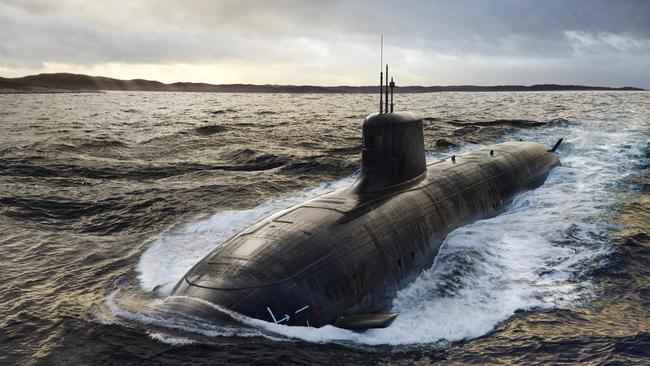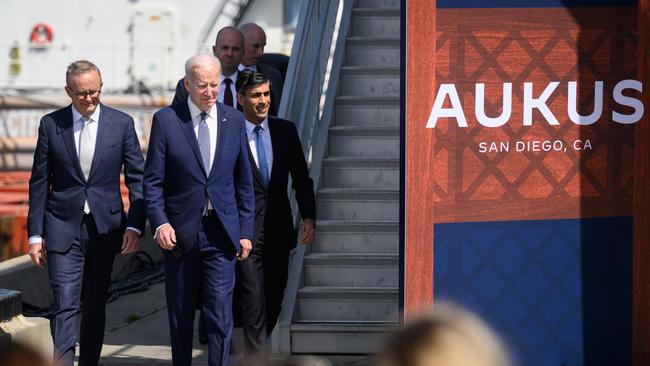AUKUS alliance: How the submarines agreement will work
Australia’s pathway to owning a fleet of nuclear submarines is a finely-tuned, risk-laden endeavour, with escalating costs and risks.

Australia’s “optimal pathway” to acquire nuclear-powered submarines is a finely tuned, risk-laden endeavour, with escalating costs and potential problems kicking in after 2027.
The multi-stage plan begins this year, with more US nuclear submarine visits to Australia, providing a growing number of training spots for Australian submariners of increasing seniority.
Australian tradespeople and professionals will also begin relocating to the US and UK this year to develop skills and support our partners’ construction schedules.
Then, from 2027, up to four US and one British submarine will begin rotational deployments that will forward-base them at HMAS Stirling near Perth.
The sale of three US-Virginia-class vessels to Australia is planned to start in the early 2030s, but importantly will be subject to congressional approval.
This leaves open the small possibility that a future US administration could refuse to honour the agreement.
The vessels will be second-hand but still have significant operational life.
There is an option to purchase another two of the US-built submarines. That decision will hinge on the next stage of the plan – the construction of the new AUKUS-class submarines in Adelaide and in the UK.
The UK expects to deliver the first of its new boats in the late 2030s, with the first Australian-built boat scheduled for completion by 2042.

The construction effort will involve all three nations, which will integrate their defence industries as never before.
As the leaders said in their joint statement: “Our plan elevates all three nations’ industrial capability to produce and sustain interoperable nuclear-powered submarines for decades to come, expands our individual and collective undersea presence in the Indo-Pacific, and contributes to global security and stability.”
Government estimates put the cost of the plan at $268bn to $368bn out to 2054-55; an estimate that includes a large contingency for unforeseen outlays and delays and will lift long-term defence spending by 0.15 per cent.
Initially, it will be cost neutral, with a $9bn budget hit over the first four years offset by already-budgeted funds for the Attack-class sub, and $3bn from Defence’s long-term funding envelope.
The plan will require Australia’s defence industry and education and training systems to lift as never before to find the 20,000 ongoing workers who will be needed to deliver the capability over the next three decades.
The government estimates an extra 500 workers will be needed from 2027 to 2030 to support the additional US and UK submarine presence at HMAS Stirling.
The construction of new shipyard facilities at Osborne in Adelaide will require an estimated 4000 workers at its peak, while a further 4000 to 5500 workers will be required in South Australia for the AUKUS submarine build.
The International Atomic Energy Agency will be consulted to ensure the program meets all the nuclear non-proliferation rules.
Under the agreement, Australia has committed to be responsible for disposing of the radioactive waste from the boats’ reactors, requiring the establishment of a domestic nuclear waste dump.
Planned life-extensions for Australia’s existing fleet of Collins-class submarines will begin in 2026 as planned, but Defence Minister Richard Marles left open the possibility that all six boats might not have to be upgraded.
British Prime Minister Rishi Sunak said the “highest priority” for AUKUS was addressing the growing threat of China and helping arm Ukraine against Russia.
“Sixty years ago, here in San Diego, President Kennedy spoke of a higher purpose: the maintenance of freedom, peace, and security,” Mr Sunak said.
“In the past 18 months, the challenge we face has only grown. Russia’s illegal invasion of Ukraine, China’s growing assertiveness, the destabilising behaviour of Iran and North Korea – all threaten to create a world defined by danger, disorder and division.”








To join the conversation, please log in. Don't have an account? Register
Join the conversation, you are commenting as Logout